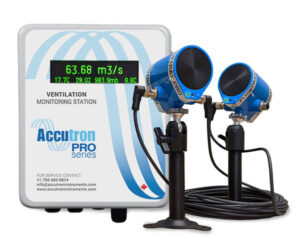Mine Ventilation Automation
Automate your ventilation systems for increased efficiency and safety.
Ventilation Automation
Ventilation in a mine is a large, complex system. The overall objective of the ventilation system is simply to provide airflow to all parts of the mine where personnel are required to be present, to dilute contaminants and ensure that air quality is safe for breathing. During the development and operation of a mine, dust, gasses, heat, fires, explosions and radiation are all factors for potential hazards. A proper ventilation automation system is key to maintaining safe working conditions.
Ventilation is a key component of mine operations. 50% of energy consumed by mining operations goes to powering ventilation systems, including heating and air. A paper published in 2012 shows that savings associated with control strategies for fluid systems – which includes pumps, fans and compressors – represents 22.20% of the total manufacturing motor system energy savings. There is a desire to improve the efficiency of ventilation systems, not only for cost reduction, but for an increase in overall heath and safety as well.
A properly monitored and automated ventilation system can increase efficiency and reduce costs of operation. What is needed to be monitored, and how can this be automated?

Airflow
One obvious parameter of key importance is airflow. Monitoring the airflow in a mine provides information as to how the air is traveling throughout the mine. If there is no airflow being detected, or an abnormally high airflow is detected, this can indicate an issue with the ventilation system. Perhaps one section of the mine is currently empty, or there is a high concentration of dust or gasses in another section. Monitoring the airflow will let you know what is going on in the ventilation system, and allow you to adjust your fans and louvers as needed. This way, the air can flow to where it is needed, and resources will not be wasted trying to provide air where it is not needed. You can find more information on measuring airflow in mines here.
Gasses
Air quality is of primary concern when dealing with ventilation systems. Monitoring gas concentrations is vital for workers safety. This information can also be used for ventilation automation before gas concentrations become too high and trigger an alarm. For instance, having active gas monitoring systems set up in an area where work is being conducted can provide real time feedback to the quality of air. If everything is at safe levels, the ventilation system can operate as normal, or even at a reduced rate. If sensors detect increasing presence of toxins in the air, then the ventilation systems can increase priority for airflow through these sections. By monitoring gasses and controlling ventilation systems as needed, energy for the ventilation system will be utilized more efficiently, resulting in lower operating costs. You can find more information about monitoring gasses in mines here.

Pressure
Pressure is an important parameter to monitor. Air will flow naturally from an area of high pressure to an area of low pressure. Actively monitoring pressure throughout the ventilation automation system can provide feedback as to how the air will naturally flow and may provide insight as to why airflow in certain sections may not be as expected.
Communications
Automation relies on communication. All the data monitored by sensors need to have a way to communicate with fans, louvers, and other ventilation components to have a successfully automated ventilation system. This can be achieved by having all the devices communicating over a network. Signals from sensors like the flow meter or gas meter are analog. These need to be converted into a digital signal and sent to a server so that the information can be accessed by anything as needed. Setting up something such as a SCADA system can provide a good overall summary of the ventilation system, and this can be used to automate ventilation processes based on the information sent to the SCADA system. More information on communication systems for mining can be found here.

